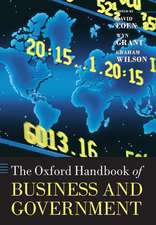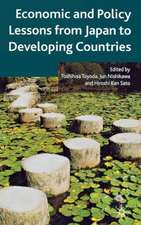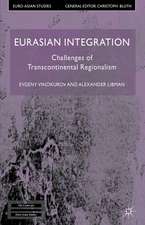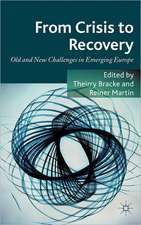Inflation and the Making of Australian Macroeconomic Policy, 1945–85
Autor Michael Beggsen Limba Engleză Hardback – 2 sep 2015
Preț: 644.82 lei
Preț vechi: 758.60 lei
-15% Nou
Puncte Express: 967
Preț estimativ în valută:
123.40€ • 128.36$ • 101.88£
123.40€ • 128.36$ • 101.88£
Carte tipărită la comandă
Livrare economică 14-28 aprilie
Preluare comenzi: 021 569.72.76
Specificații
ISBN-13: 9781137265968
ISBN-10: 1137265965
Pagini: 320
Ilustrații: XII, 325 p. 12 illus.
Dimensiuni: 140 x 216 x 21 mm
Greutate: 0.54 kg
Ediția:1st ed. 2015
Editura: Palgrave Macmillan UK
Colecția Palgrave Macmillan
Locul publicării:London, United Kingdom
ISBN-10: 1137265965
Pagini: 320
Ilustrații: XII, 325 p. 12 illus.
Dimensiuni: 140 x 216 x 21 mm
Greutate: 0.54 kg
Ediția:1st ed. 2015
Editura: Palgrave Macmillan UK
Colecția Palgrave Macmillan
Locul publicării:London, United Kingdom
Cuprins
Contents
1. Inflation, The State And Economic Policy
1.1. Fighting Inflation First
1.1.1. The Origin Myth Of The ''New Macroeconomic Consensus''
1.1.2. From ''Keynesianism'' To ''Neoliberalism''
1.2. Explaining Policy
1.2.1. Economic Policy As An Emergent Strategic Agent
1.2.2. Thinking Like A State About Political-Economic Tensions
1.2.3. Inflation As A Policy Problem
1.3. The Structure Of This Book
1.3.1. The Long 1950s
1.3.2. The Long 1970s
Part I: The Long 1950s
2. ''External Balance'' And The Counter-Inflationary Imperative
2.1. Internalising External Balance
2.1.1. A Conflict Foretold
2.1.2. ''A Balance Of Hopes And Desires'': Bretton Woods Shapes The Constraint
2.1.3. Swan''s Way: A Contemporary Model Of Policy Coherence
2.2. Beyond Swan
2.2.1. The Stylised Facts
2.2.2. The Period As A Whole
2.2.3. Breaking Down The Period
2.2.4. Capital Inflow And Wool Boom: To 1950/51
2.2.5. Recurring Crisis: 1951/52-1960/61
2.2.6. The Reprieve: 1961/62-64/65
2.3. Rules And Strategies Of The Game
3. Inflation And The Keynesianism Of Restraint
3.1. In Everybody''s Interest
3.2. The Making Of Fiscal Policy
3.2.1. To The ''Horror Budget''
3.2.2. Fiscal Policy In The Fifties
The ''Horror Budget'' In Perspective
Another Round Of Restraint: Mid-1950s
Credit Squeeze And Aftermath: Early 1960s
3.3. Inflation Theory In The 1950s
3.3.1. Towards Dynamics
3.3.2. Cost-Push, Demand-Pull, Wages And Distributional Struggle
3.4. Targeting Wages
3.5. Phillips In Melbourne
3.6. A Period Of Calm
4. From The ''Battle For The Banks'' To The ''Credit Sqeeze'': Monetary Policy In The Long 1950s ?
4.1. An Unusual History
4.2. Boundaries And Strategies
4.2.1. The Mystery Element In Monetary Policy
4.2.2. Banks And Markets
4.3. Strengthening The Chain
4.3.1. Lessons Of The Wool Boom
4.3.2. Pursuing A Liquidity Norm 4.4. Beyond The Banks
4.4.1. The Finance Companies And The Birth Of The Money Market
4.4.2. The ''Credit Squeeze'' And New Strategy
4.5. Concusion
Part II: The Long 1970s
5. From Bretton Woods To The Float
5.1. Constraint Changes Form
5.2. From ''The Balance-Of-Payments Constraint'' To ''Imported Inflation''
5.2.1. Footnotes To Swan
5.2.2. The Constraint Relaxes
5.2.3. ''Imported Inflation''
5.3. Capital Flows And Macroeconomic Policy
5.3.1. The Canadian Contribution To Balance-Of-Payments Theory
5.3.2. The Monetary Approach To The Balance Of Payments
5.3.3. Capital Flows And Monetary Policy In The Early 1970s
5.4. Flexible Exchange Rates
5.4.1. High-Dollar Discipline And Its Enemies: January 1973-November 1976
5.4.2. Towards The Float: November 1976-December 1983
5.5. The Float In Retrospect
6. Inflation And Macroeconomic Policy In The Long 1970s
6.1. Introduction
6.2. Demand Policy, Inflation And Unemployment
6.2.1. An Overview Of Fiscal Policy In The Long 1970s
6.3. Augmenting The Phillips Curve
6.3.1. Australian Natural-Rate Expectations-Augmented Phillips Curve Studies ?
6.4. Distributional Conflict And ''Fighting Inflation First''
6.4.1. Incomes Policy
6.5 Conclusion
7. Stengthening The Central Bank
7.1. Introduction
7.2. Banks, Markets And Monetary Policy Into The 1970s
7.2.1. Policy, Banks And Markets
7.2.2. Market Development In The 1960s And 1970s
7.2.3. Policy Eclecticism
7.3. ''Through Fire Or Over Ground Which Moves'': Monetarism In Australia
7.3.1. Long And Variable Lags: Monetarism And The Econometricians
7.3.2. Implementing The Targets
7.4. Towards Deregulation
Conclusion
8.1. A Long View
8.1.1. Managed Money
8.1.2. A ''Labour Standard''?
8.1.3. Mutations Of ''Mnaged Money'' In Australia
8.2. The Accord Alternative?
8.2.1. The Accord In Action
8.2.2. The Accord As Qualitative Policy
8.3. Conclusion
Bibliography
1. Inflation, The State And Economic Policy
1.1. Fighting Inflation First
1.1.1. The Origin Myth Of The ''New Macroeconomic Consensus''
1.1.2. From ''Keynesianism'' To ''Neoliberalism''
1.2. Explaining Policy
1.2.1. Economic Policy As An Emergent Strategic Agent
1.2.2. Thinking Like A State About Political-Economic Tensions
1.2.3. Inflation As A Policy Problem
1.3. The Structure Of This Book
1.3.1. The Long 1950s
1.3.2. The Long 1970s
Part I: The Long 1950s
2. ''External Balance'' And The Counter-Inflationary Imperative
2.1. Internalising External Balance
2.1.1. A Conflict Foretold
2.1.2. ''A Balance Of Hopes And Desires'': Bretton Woods Shapes The Constraint
2.1.3. Swan''s Way: A Contemporary Model Of Policy Coherence
2.2. Beyond Swan
2.2.1. The Stylised Facts
2.2.2. The Period As A Whole
2.2.3. Breaking Down The Period
2.2.4. Capital Inflow And Wool Boom: To 1950/51
2.2.5. Recurring Crisis: 1951/52-1960/61
2.2.6. The Reprieve: 1961/62-64/65
2.3. Rules And Strategies Of The Game
3. Inflation And The Keynesianism Of Restraint
3.1. In Everybody''s Interest
3.2. The Making Of Fiscal Policy
3.2.1. To The ''Horror Budget''
3.2.2. Fiscal Policy In The Fifties
The ''Horror Budget'' In Perspective
Another Round Of Restraint: Mid-1950s
Credit Squeeze And Aftermath: Early 1960s
3.3. Inflation Theory In The 1950s
3.3.1. Towards Dynamics
3.3.2. Cost-Push, Demand-Pull, Wages And Distributional Struggle
3.4. Targeting Wages
3.5. Phillips In Melbourne
3.6. A Period Of Calm
4. From The ''Battle For The Banks'' To The ''Credit Sqeeze'': Monetary Policy In The Long 1950s ?
4.1. An Unusual History
4.2. Boundaries And Strategies
4.2.1. The Mystery Element In Monetary Policy
4.2.2. Banks And Markets
4.3. Strengthening The Chain
4.3.1. Lessons Of The Wool Boom
4.3.2. Pursuing A Liquidity Norm 4.4. Beyond The Banks
4.4.1. The Finance Companies And The Birth Of The Money Market
4.4.2. The ''Credit Squeeze'' And New Strategy
4.5. Concusion
Part II: The Long 1970s
5. From Bretton Woods To The Float
5.1. Constraint Changes Form
5.2. From ''The Balance-Of-Payments Constraint'' To ''Imported Inflation''
5.2.1. Footnotes To Swan
5.2.2. The Constraint Relaxes
5.2.3. ''Imported Inflation''
5.3. Capital Flows And Macroeconomic Policy
5.3.1. The Canadian Contribution To Balance-Of-Payments Theory
5.3.2. The Monetary Approach To The Balance Of Payments
5.3.3. Capital Flows And Monetary Policy In The Early 1970s
5.4. Flexible Exchange Rates
5.4.1. High-Dollar Discipline And Its Enemies: January 1973-November 1976
5.4.2. Towards The Float: November 1976-December 1983
5.5. The Float In Retrospect
6. Inflation And Macroeconomic Policy In The Long 1970s
6.1. Introduction
6.2. Demand Policy, Inflation And Unemployment
6.2.1. An Overview Of Fiscal Policy In The Long 1970s
6.3. Augmenting The Phillips Curve
6.3.1. Australian Natural-Rate Expectations-Augmented Phillips Curve Studies ?
6.4. Distributional Conflict And ''Fighting Inflation First''
6.4.1. Incomes Policy
6.5 Conclusion
7. Stengthening The Central Bank
7.1. Introduction
7.2. Banks, Markets And Monetary Policy Into The 1970s
7.2.1. Policy, Banks And Markets
7.2.2. Market Development In The 1960s And 1970s
7.2.3. Policy Eclecticism
7.3. ''Through Fire Or Over Ground Which Moves'': Monetarism In Australia
7.3.1. Long And Variable Lags: Monetarism And The Econometricians
7.3.2. Implementing The Targets
7.4. Towards Deregulation
Conclusion
8.1. A Long View
8.1.1. Managed Money
8.1.2. A ''Labour Standard''?
8.1.3. Mutations Of ''Mnaged Money'' In Australia
8.2. The Accord Alternative?
8.2.1. The Accord In Action
8.2.2. The Accord As Qualitative Policy
8.3. Conclusion
Bibliography
Recenzii
“The essential facts about the rise and fall of inflation are discussed and the related literature is reviewed. These aspects of the book are generally well done, … book aimed at attracting the attention of a wider audience: … .” (Selwyn Cornish, Economic Record, Vol. 93 (300), March, 2017)
Notă biografică
Michael Beggs is a Lecturer in Political Economy at the University of Sydney, Australia, where he works on the history of monetary thought and policy.














